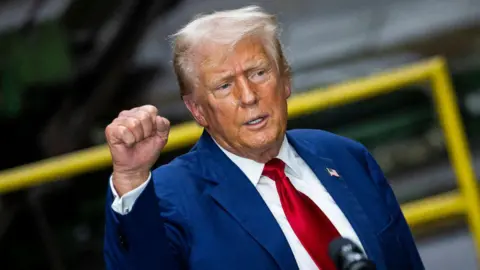Why this US jobs report matters – and what to watch

 Getty Images
Getty ImagesIf you care about where the US economy is headed, you might want to keep an eye on events on Friday.
At 08:30 ET (13.30 BST), the US Labor Department will release the results of its monthly jobs surveys of employers and households.
The report is one of the most important gauges of the state of the world’s largest economy – and it is coming at a critical time.
The US presidential campaign, in which voters have identified the economy as a top concern, is underway. And after several years focused on inflation worries, attention is starting to turn to the job market.
What to watch – the unemployment rate
Last month, the Labor Department reported the unemployment rate had hit 4.3% in July, up from 3.5% a year earlier, as jobs growth slowed.
The news helped to fuel several days of stock market turmoil.
If Friday’s report shows further cracks forming in the job market that would be bad news for Democrats, undermining the story they have been telling of an economy that is healthy, if slowing, returning to sustainable growth, after a post-pandemic boom.
How much we should worry is still up for debate.
Such an increase often signals an economic recession – but forecasters say that prediction is less certain this time, noting factors like a surge in immigration that have complicated the picture.
Other data suggest the rise in unemployment rate has been driven by more people looking for work, rather than a sharp rise in job cuts.
Friday’s report will help to flesh out that puzzle, offering a key piece of evidence as voters impressions start to cement ahead of the November vote.
Soft vs hard landing
Republicans have been keen to point to any bad news – a stock market stumble, lower growth figures, slowing business investment and a dip in hiring – as evidence that a change of leadership in Washington is necessary.
Part of what has kept Democrats on the defensive about the economy is the unusual mix of forces at play right now.
The US central bank raised borrowing costs sharply two years ago, responding to prices that were jumping at the fastest rate since the 1980s.
The Federal Reserve said the moves – which brought its key lending rate to a roughly two decade high of 5.3% – would help get inflation under control.
But the way they do that is by discouraging business expansions and other big spending and dampening the pressures pushing up prices.
Put more simply, the Fed is deliberately slowing the economy.
That often doesn’t end well.
Historically, a big jump in rates typically ends in a recession – and the stock market has been jittery over any signs of that the economy is headed for a “hard landing”.
 Getty Images
Getty ImagesDonald Trump has fanned the fears, for months predicting an economic “crash” – especially if his opponent is elected.
Polls suggest a majority of Americans have already spent much of the last few years believing the economy is in recession – a downbeat assessment at odds with the country’s 2.5% growth last year.
Many analysts blame the disconnect on inflation, as households balk at prices that have jumped nearly 20% over four years.
But the urgency of that issue has abated, as wages rise and inflation subsides, dropping to 2.9% in the most recent official reading – the slowest pace since March 2021.
Fed rate cut
That has set the stage for the Fed to lower interest rates for the first time in four years, which could bring further financial relief, leading to lower borrowing costs for mortgages, car loans, credit cards and other forms of debt.
Friday’s job report will be key to confirming the timing and size of the cut – and if it is actually likely to end up boosting sentiment and helping Democrats, as expected.
For now, most analysts expect a cut of 0.25 percentage points, which would signal an ongoing, orderly slowdown.
If the figures fuel worries about the economy, however, a bigger cut might be in order – though a cut driven by a stuttering economy and Americans losing jobs would hardly prove a benefit to Democrats.
Conversely, booming jobs numbers might make the bank rethink whether the economy is still running too hot and a cut is necessary at all.
That has left the Harris campaign in a peculiar position – hoping for a good jobs report, but not a great one.
In a closely watched speech last month, Federal Reserve chairman Jerome Powell left his options for how big a cut might be on the table.
Friday’s jobs report may start closing some doors.
Related
U.S. economy adds jobs as federal layoffs and rising unemployment…
Julia Coronado: I think it's too early to say that the U.S. is heading to a recession. Certainly, we have seen the U.S. just continue t
The job listing site highlighting H-1B positions so Americans can…
A mysterious new job listings website recently went live, solely showing roles companies want to offer to their H-1B holders seeking Green Cards in an attempt t
Tepid February Jobs Report Boosts Odds of a June Fed…
Federal Reserve Board Chairman Jerome Powell speaks during a news conference. Photo by Chip ... [+] Somodevilla/Getty Images.Getty Images The February jobs repo
French university offers jobs to American scientists afraid of government…
As the current federal government in the U.S. has been freezing or cutting funding for several research grants, a French university has stepped in with an offer














